10 Benefits of Predictive Analytics Consulting for Market Analysts

10 Benefits of Predictive Analytics Consulting for Market Analysts
Overview
The article emphasizes the advantages of predictive analytics consulting for market analysts, showcasing how it enhances decision-making, reduces costs, and improves customer insights. One of the key features of this consulting is its ability to leverage data effectively. By analyzing historical data, organizations can anticipate market trends, allowing them to make informed decisions that optimize resource allocation. This not only leads to cost reductions but also enables companies to tailor customer experiences more precisely.
The benefits of predictive analytics are evident through various examples. For instance, organizations that have adopted these practices report increased efficiency and a competitive edge in their respective markets. This illustrates the significant impact that predictive analytics can have on operational success. How can your organization utilize these insights to stay ahead of the competition?
In conclusion, the integration of predictive analytics consulting into market analysis processes offers substantial benefits. By enhancing decision-making capabilities and improving customer insights, organizations can position themselves strategically in the market. As you consider the implications of these insights, think about how predictive analytics could transform your approach to market analysis.
Introduction
The rise of data-driven decision-making has transformed the landscape of market analysis, positioning predictive analytics consulting as an indispensable tool for organizations striving to excel in competitive environments. By leveraging historical data and advanced algorithms, businesses unlock valuable insights that enhance strategic planning, optimize operations, and improve customer engagement. Yet, a pressing challenge persists: how can companies effectively harness these insights to not only stay ahead of market trends but also mitigate risks and drive sustainable growth? This article explores ten key benefits of predictive analytics consulting, revealing how it empowers market analysts to navigate complexities and seize opportunities in an ever-evolving marketplace.
Initial Data Offering: Streamlined Access to Quality Datasets for Predictive Analytics
The Initial Data Offering (IDO) serves as a vital platform that simplifies the introduction and exploration of new datasets. This accessibility is crucial for market analysts seeking high-quality information essential for predictive analytics consulting. By curating datasets across various domains—including finance, social media, and environmental studies—IDO significantly enhances the visibility of valuable resources. Notably, 71% of companies acknowledge that high-quality data is critical for informed decision-making in market research, underscoring the importance of IDO's offerings.
With new datasets being added daily, IDO ensures that users remain informed about the latest trends and insights necessary for effective forecasting. The integrity of these datasets directly impacts the accuracy of predictive models, which highlights the critical role that predictive analytics consulting plays in data-driven strategies. As the demand for reliable datasets continues to rise, organizations are increasingly focusing on information quality, utilizing predictive analytics consulting to mitigate risks and support strategic initiatives.
IDO's commitment to providing a robust marketplace for information exchange, combined with its AI-driven business intelligence solutions, positions it as a significant contributor to enhancing dataset discovery and accessibility for market analysts. By subscribing to the Initial Data Offering, users gain premium access to exclusive collections and insights, equipping them to stay ahead in the rapidly evolving landscape of information analysis.
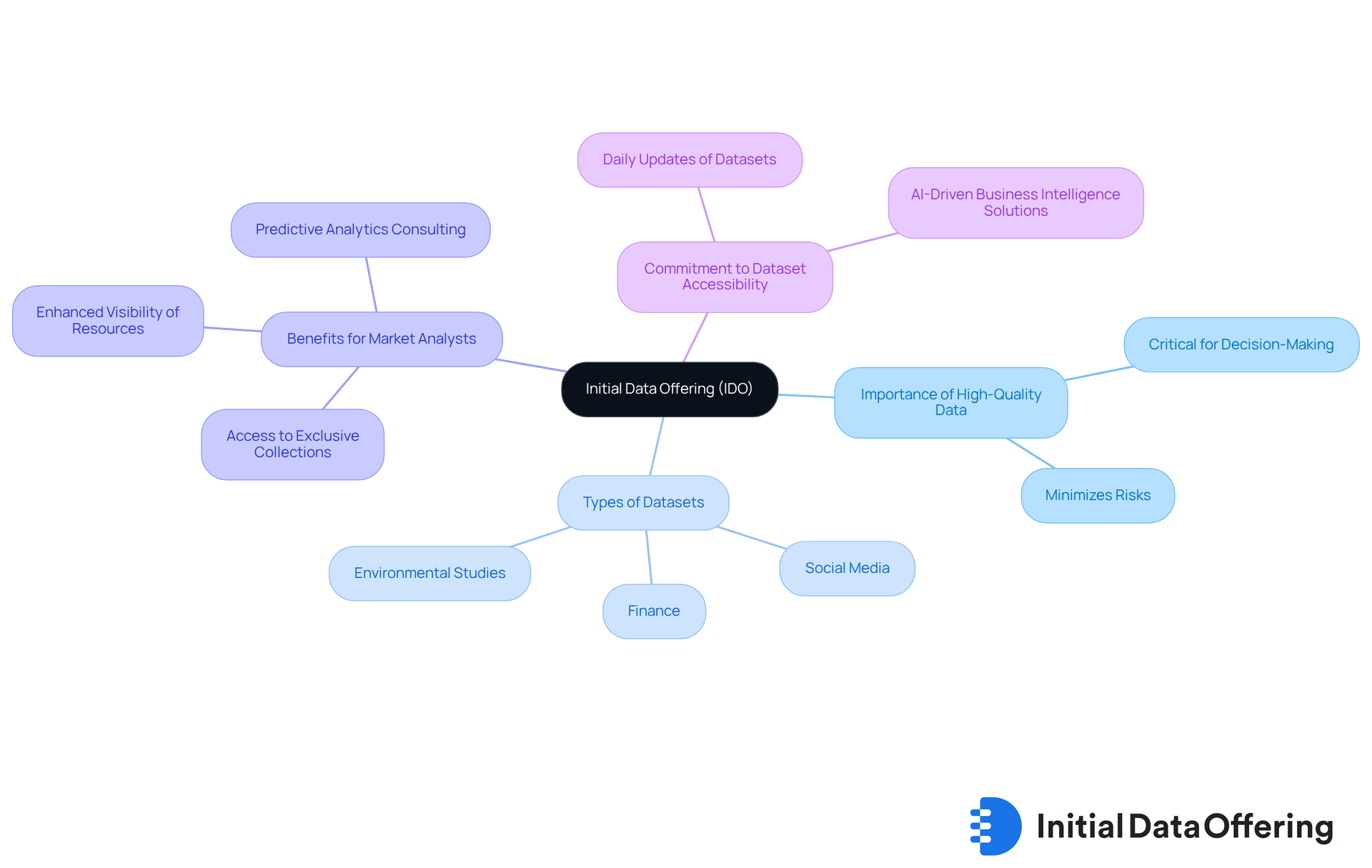
Enhanced Decision-Making: Leveraging Data Insights for Strategic Business Planning
Companies can benefit from predictive analytics consulting, which empowers them to make informed decisions by examining historical data and identifying trends that forecast future outcomes. This data-driven approach, supported by predictive analytics consulting, enhances strategic planning, allowing businesses to anticipate market shifts and respond proactively to changes in consumer behavior. By leveraging these insights, organizations not only improve decision-making accuracy but also foster a culture of agility and responsiveness. As David Henkin observes, 'Predictive analytics consulting has evolved from a niche discipline into a mainstream necessity,' highlighting its essential role in navigating today’s dynamic market landscape.
For instance, retailers utilize forecasting techniques to predict demand, enabling them to manage inventory levels efficiently and avoid stockouts or excess stock. This proactive approach can lead to reduced costs and increased sales. Companies like Walmart exemplify this by analyzing purchasing patterns and local events to optimize stock allocations, thereby minimizing stockouts and overstocks, which ultimately results in enhanced customer satisfaction.
Moreover, UPS employs forecasting data to refine delivery routes, analyzing extensive datasets to decrease fuel consumption and logistics costs. Such applications not only enhance decision-making precision but also cultivate a culture of agility within enterprises. In fact, 56% of companies report that forecasting data has led to quicker, more efficient decision-making, reinforcing its vital role in today’s fast-paced market environment.
Integrating predictive analytics consulting into strategic planning allows companies to refine their marketing strategies, adjust inventory levels, and modify product designs based on anticipated consumer behavior. By utilizing these data-driven insights, businesses can proactively tailor their offerings, thereby strengthening customer relationships and fostering loyalty over time. With the forecasting data market projected to grow significantly, with estimates for 2025 ranging from $17 billion to $22 billion, organizations that effectively harness these insights are better positioned to seize opportunities and make strategic decisions that drive growth and profitability.
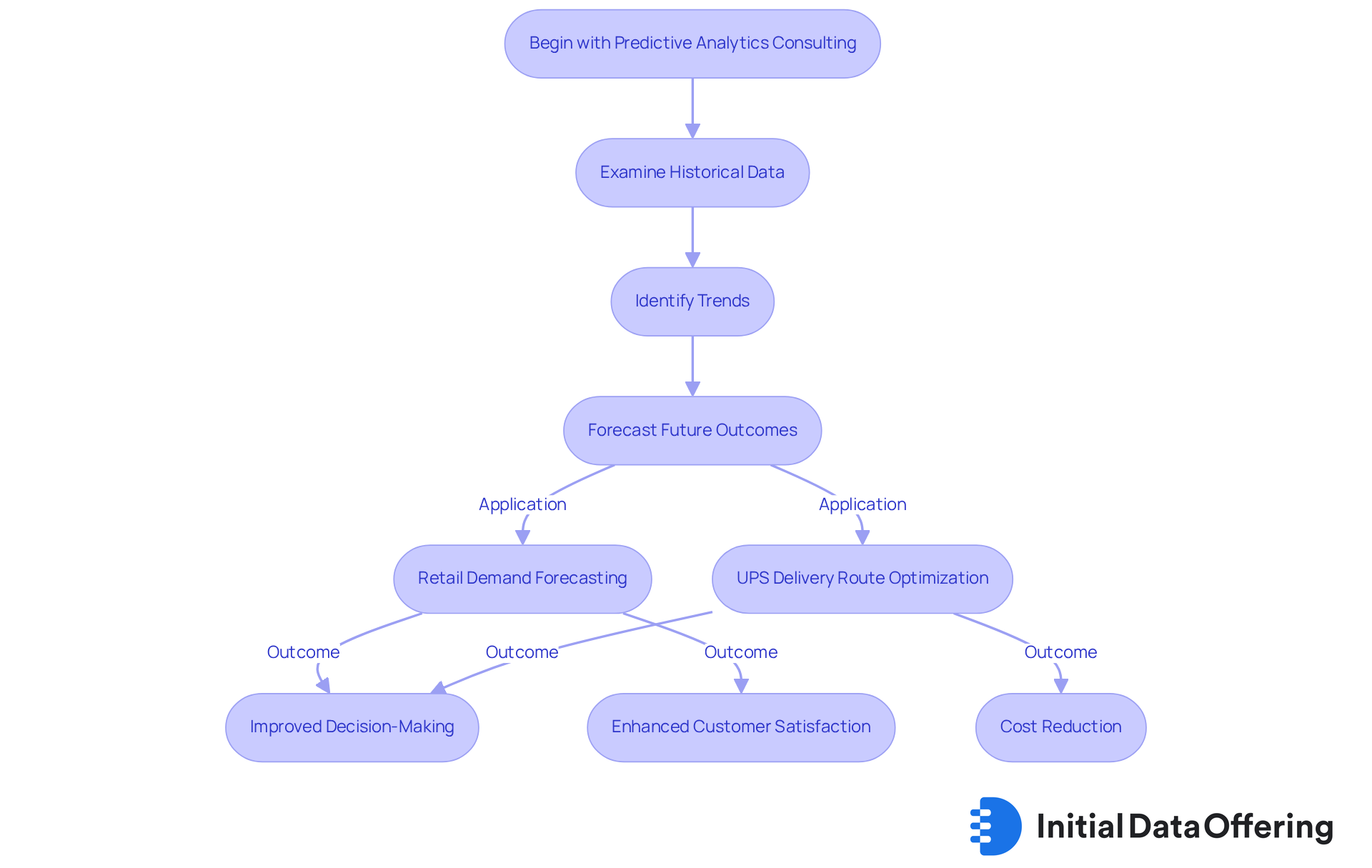
Cost Savings: Reducing Operational Expenses Through Predictive Analytics
Applying predictive analytics consulting can lead to substantial cost reductions by enhancing resource distribution and minimizing waste. Companies utilizing forecasting models can leverage predictive analytics consulting to precisely predict demand, which helps in minimizing surplus inventory and the associated holding expenses. Additionally, implementing predictive analytics consulting strategies contributes to cost efficiency by identifying potential equipment failures before they escalate, thus preventing costly downtime and maintenance expenses.
Statistics indicate that anticipatory maintenance can lower maintenance costs by up to 40% and reduce equipment downtime by as much as 50%. Furthermore, entities that implement forecasting data techniques report a 30-50% improvement in equipment reliability, resulting in enhanced operational efficiency. According to research from McKinsey, leading organizations achieve ROI ratios ranging from 10:1 to 30:1 within 12-18 months of implementation.
Overall, the financial advantages of predictive analytics consulting can significantly boost an organization's profits, establishing it as a crucial element of contemporary business strategy. How might these insights apply to your organization? Consider the potential benefits of integrating forecasting analytics into your operational framework.

Competitive Advantage: Staying Ahead with Predictive Analytics Insights
Organizations that effectively utilize predictive analytics consulting can secure a substantial competitive advantage by anticipating market shifts and consumer preferences. This capability allows businesses to leverage predictive analytics consulting to meticulously analyze trends and patterns within their data, enabling proactive decisions that place them ahead of their rivals. For instance, retailers such as Amazon and Walmart leverage analytical insights to enhance their marketing strategies, ensuring they connect with the appropriate audience through customized messaging at ideal times.
Walmart, for example, analyzes purchasing patterns, local events, and seasonal trends to optimize stock allocations. This proactive approach minimizes stockouts and overstocks, significantly boosting customer engagement and driving sales growth. In fact, companies that embrace forecasting methods are projected to outperform those relying solely on intuition. Studies indicate that organizations anticipating customer needs will see enhanced performance metrics by 2025.
As forecasting analysis continues to advance, its incorporation into marketing approaches will become increasingly essential for companies seeking to succeed in a competitive environment. Moreover, the quality of information utilized in predictive analytics consulting is crucial; clean, up-to-date, and pertinent information guarantees effective results. This emphasizes the necessity for businesses to prioritize information quality in their analysis efforts.
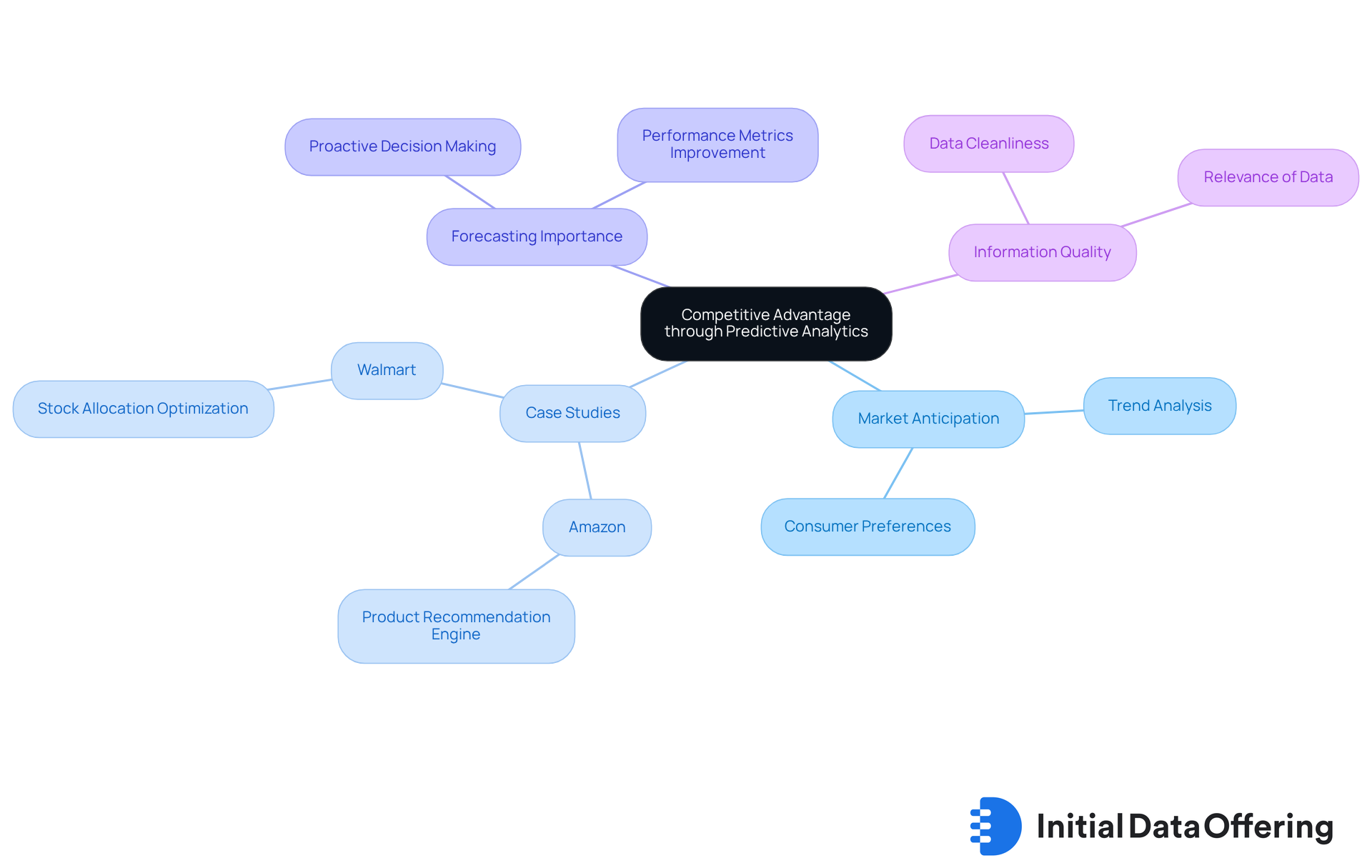
Risk Management: Identifying and Mitigating Risks with Predictive Analytics
Predictive analytics plays a vital role in risk management by enabling entities to identify potential risks before they materialize. By analyzing historical data and recognizing patterns, businesses can forecast risks related to market fluctuations, operational challenges, and compliance issues. This proactive approach allows organizations to implement mitigation strategies in advance, reducing the likelihood of adverse impacts on their operations and financial performance.
The worldwide forecasting analysis market is expected to attain $35.45 billion by 2027, expanding at a CAGR of 21.9% from 2020 to 2027. This growth highlights the rising significance of forecasting in risk management. Financial institutions have successfully employed forecasting models to enhance their risk management strategies, leading to a 25% improvement in the accuracy of credit risk evaluations. This not only minimizes default rates but also optimizes decision-making processes. Furthermore, a leading bank's deployment of a real-time fraud detection system averted losses surpassing $10 million in one quarter, underscoring the concrete advantages of analytical forecasting in recognizing and reducing risks.
Industry specialists stress the importance of utilizing information effectively. As Georgina Wainwright from Airmic observes, entities must adjust their procedures according to anticipatory insights to prevent or lessen potential losses. This sentiment is echoed by Philip Songhurst-Thonet, who emphasizes the significance of beginning modestly and concentrating on particular risks to enhance the effectiveness of risk information. Nevertheless, obstacles like information quality and accessibility can impede the acceptance of forecast analysis, making it crucial for companies to tackle these problems.
The integration of predictive analytics consulting into risk management frameworks is becoming increasingly vital as organizations navigate a volatile landscape. For example, advancements in IoT and large-scale information technologies facilitate ongoing surveillance of risks in sectors like manufacturing, anticipating equipment malfunctions and minimizing operational losses. By harnessing the power of data, businesses can not only foresee potential threats but also enhance their overall resilience and strategic planning capabilities.
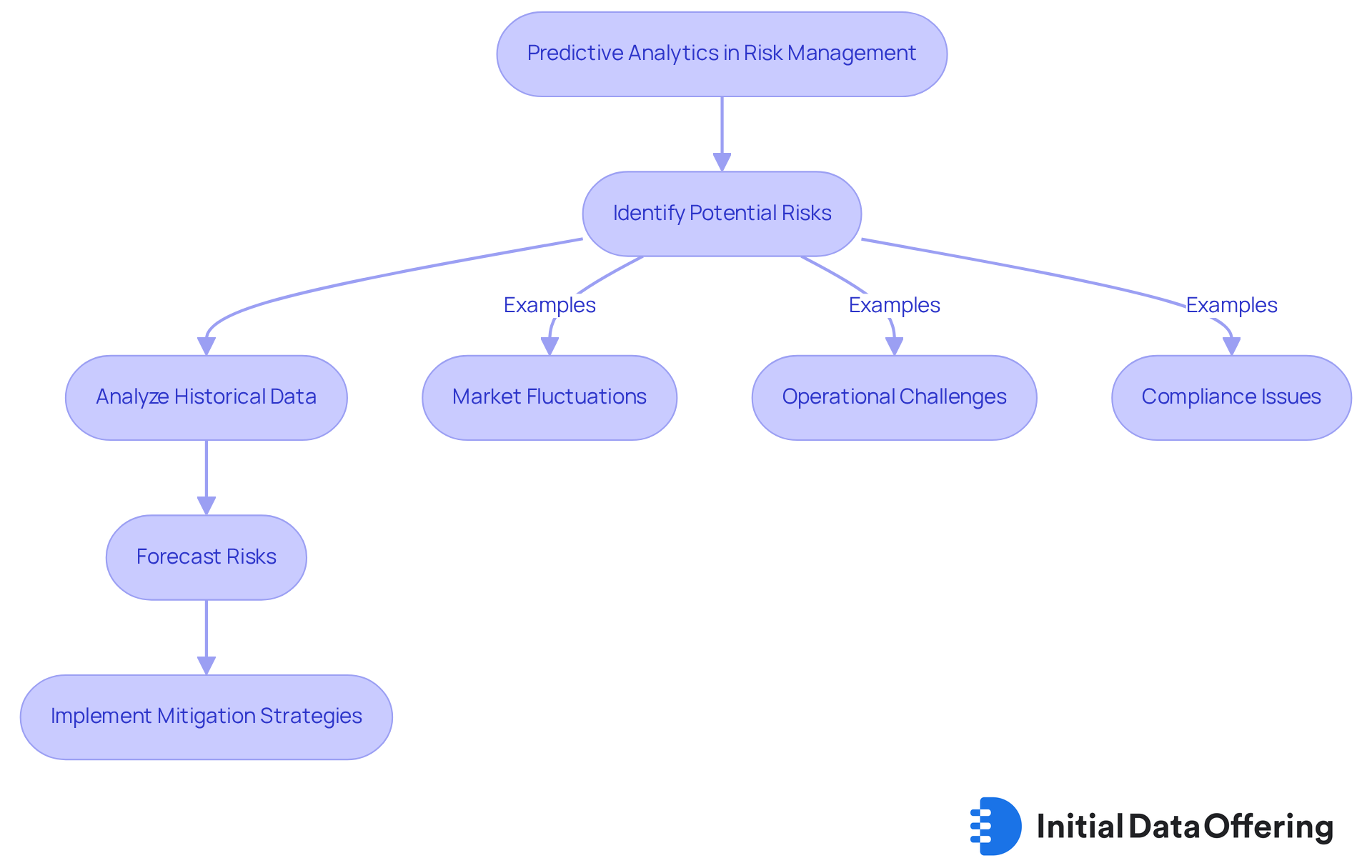
Customized Solutions: Tailoring Predictive Analytics to Meet Business Needs
Each entity encounters unique challenges and goals, making it essential to tailor predictive analytics consulting to meet specific business requirements. By customizing models and algorithms, businesses can enhance the relevance of insights generated, ultimately improving decision-making effectiveness. Partnering with data specialists enables entities to create solutions that directly address their specific operational issues and market conditions.
For instance, Ford successfully implemented IBM SPSS Modeler to predict vehicle demand, resulting in significant cost savings and improved supply chain efficiency. Predictive models can be developed to anticipate customer behavior, improve inventory management, or refine marketing strategies, ensuring that data-driven efforts are not only pertinent but also actionable. This customized approach is supported by data indicating that 87% of firms view forecasting insights as a crucial element in their business strategy, underscoring the importance of aligning analysis with strategic objectives.
Moreover, firms that invest in building robust data analysis teams are more likely to achieve substantial business results, highlighting the significance of tailored predictive insights in fostering growth and innovation. However, entities must also navigate challenges such as ensuring data quality and addressing ethical issues, which are critical for successful implementation. As Gartner observes, companies that establish strong data analysis teams are more likely to attain significant business outcomes, emphasizing the importance of skilled collaboration in this process.

Improved Customer Insights: Enhancing Satisfaction Through Predictive Analytics
Predictive analytics consulting empowers organizations to delve deeper into customer behavior, preferences, and needs. By meticulously analyzing historical data, businesses can leverage predictive analytics consulting to uncover trends that shape product development, marketing strategies, and customer engagement initiatives. This profound understanding enables companies to utilize predictive analytics consulting to customize their offerings, aligning them with customer expectations and ultimately enhancing satisfaction and loyalty.
How can predictive analytics consulting transform your approach to customer engagement? For example, companies can utilize predictive analytics consulting to forecast customer needs and proactively address them, creating a more personalized experience. Businesses such as H&M employ forecasting methods to track social media discussions, modifying their tactics to remain at the forefront of new trends. Similarly, Starbucks customizes its loyalty program according to personal purchasing behaviors, greatly enhancing engagement.
Such data-focused methods, including predictive analytics consulting, not only enhance customer satisfaction but also promote long-term loyalty. This illustrates the essential role of predictive analytics consulting in contemporary business strategies. By leveraging these insights, organizations can ensure they meet and exceed customer expectations, fostering a deeper connection with their audience.

Scalability: Adapting Predictive Analytics Solutions for Business Growth
Scalability is crucial for entities striving to apply forecasting analysis solutions effectively. As companies expand, they produce large volumes of information that require sophisticated analysis skills. Scalable predictive analytics consulting solutions are designed to handle growing information volumes without compromising performance. This ensures that companies can derive valuable insights as they expand, which is essential for maintaining a competitive edge in dynamic markets.
By investing in scalable data analysis platforms, businesses not only future-proof their operations but also enhance their ability to utilize predictive analytics consulting for making data-driven decisions that support sustained growth. Technology leaders emphasize that as data requirements increase, the capability to expand analysis efficiently becomes a critical factor for success. This adaptability allows enterprises to react quickly to market shifts and customer demands.
Consider how your organization can leverage scalable solutions to improve decision-making and operational efficiency. The right tools can transform vast amounts of data into actionable insights, ultimately driving growth and innovation.

Advanced Technology Integration: Utilizing AI and Machine Learning in Predictive Analytics
Incorporating advanced technologies such as artificial intelligence (AI) and machine learning into forecasting methods significantly improves model precision and effectiveness. These innovations allow organizations to process vast datasets swiftly, revealing intricate patterns and generating more precise forecasts. For example, companies utilizing AI-driven predictive insights can automate decision-making, enhance operations, and greatly improve performance.
Notably, companies employing machine learning have reported sales growth rates 5-6% higher than their counterparts who do not adopt these technologies. This statistic highlights the connection between predictive analytics consulting and operational efficiency, emphasizing the tangible benefits of technology adoption. How can your organization leverage these insights to enhance its performance?
This technological advancement not only empowers companies to maintain a competitive edge but also enables them to respond proactively to market fluctuations. As AI continues to refine predictions with each new dataset, machine learning improves over time, further enhancing accuracy and operational efficiency. However, entities must also tackle challenges such as information quality problems and the intricacy of model interpretability.
Creating strong information pipelines is vital to guarantee accuracy, diversity, and timeliness, making it a crucial element of contemporary business strategy. By addressing these challenges, organizations can fully harness the power of AI and machine learning to drive growth and innovation.
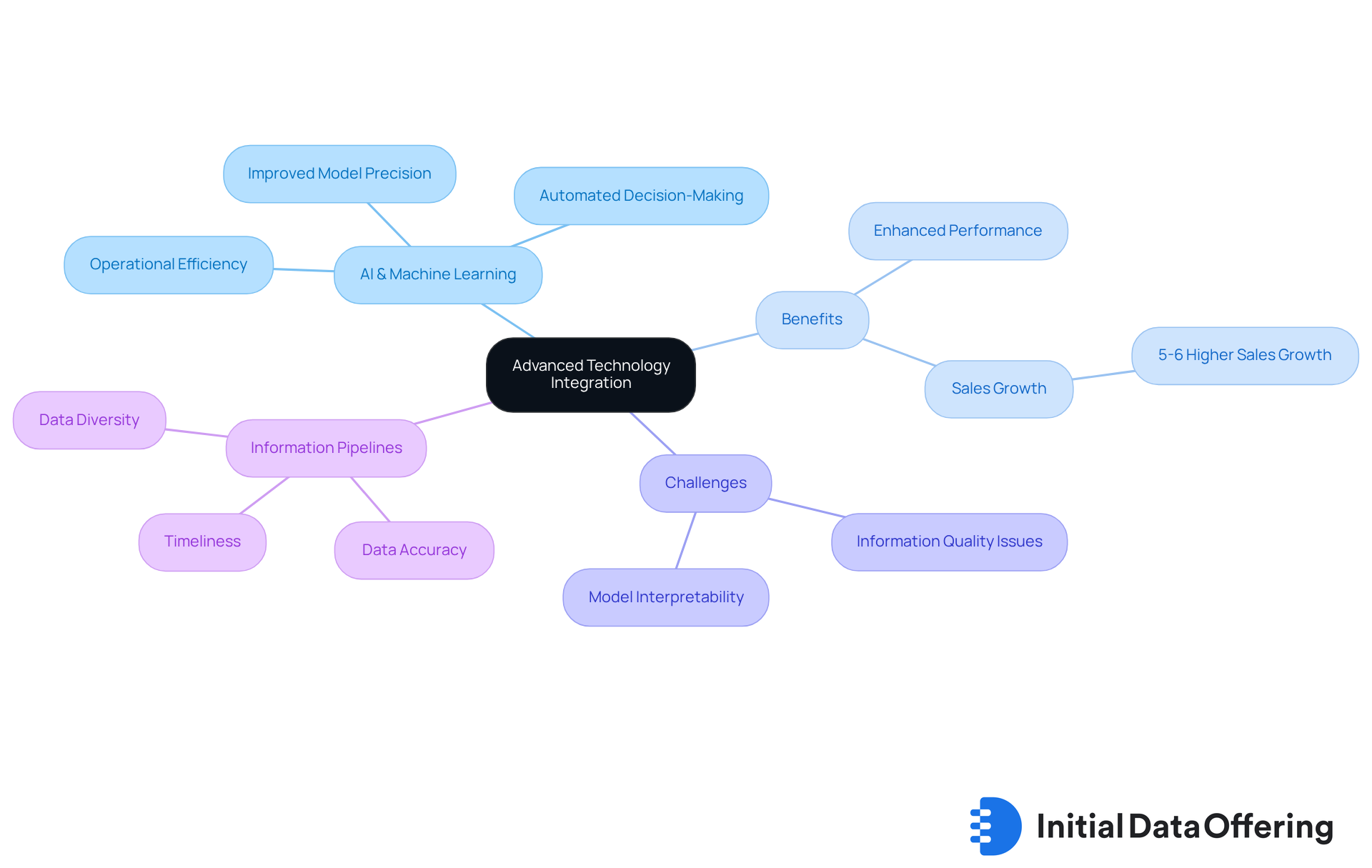
Ongoing Support and Training: Empowering Businesses with Predictive Analytics Expertise
To enhance the benefits of forecast analysis, organizations must emphasize continuous support and education for their teams. This investment guarantees that employees possess the necessary skills to analyze insights and apply them effectively in decision-making processes. Thorough training programs should encompass various aspects of forecasting data, such as:
- Data interpretation
- Model development
- The use of advanced analytical tools
For instance, companies like IBM have reported a 20% increase in project success rates due to enhanced staff competency in critical areas. This demonstrates the tangible benefits of well-structured training initiatives.
Fostering a culture of continuous learning not only empowers teams but also drives innovation and growth. Organizations that implement customized training programs can observe substantial enhancements in analytical effectiveness. Deloitte discovered that personalized training resulted in a 60% rise in employee involvement with training programs. Furthermore, continuous assistance aids teams in managing the intricacies of forecasting data, ensuring they can adapt to advancing technologies and approaches.
Investing in strong data infrastructure and promoting data literacy among employees are essential for effective forecasting implementation, as 60% of maintenance professionals indicated that dependable data is vital for success. By equipping employees with the necessary skills and resources, businesses can harness the full potential of predictive analytics consulting, ultimately enhancing their strategic decision-making capabilities.
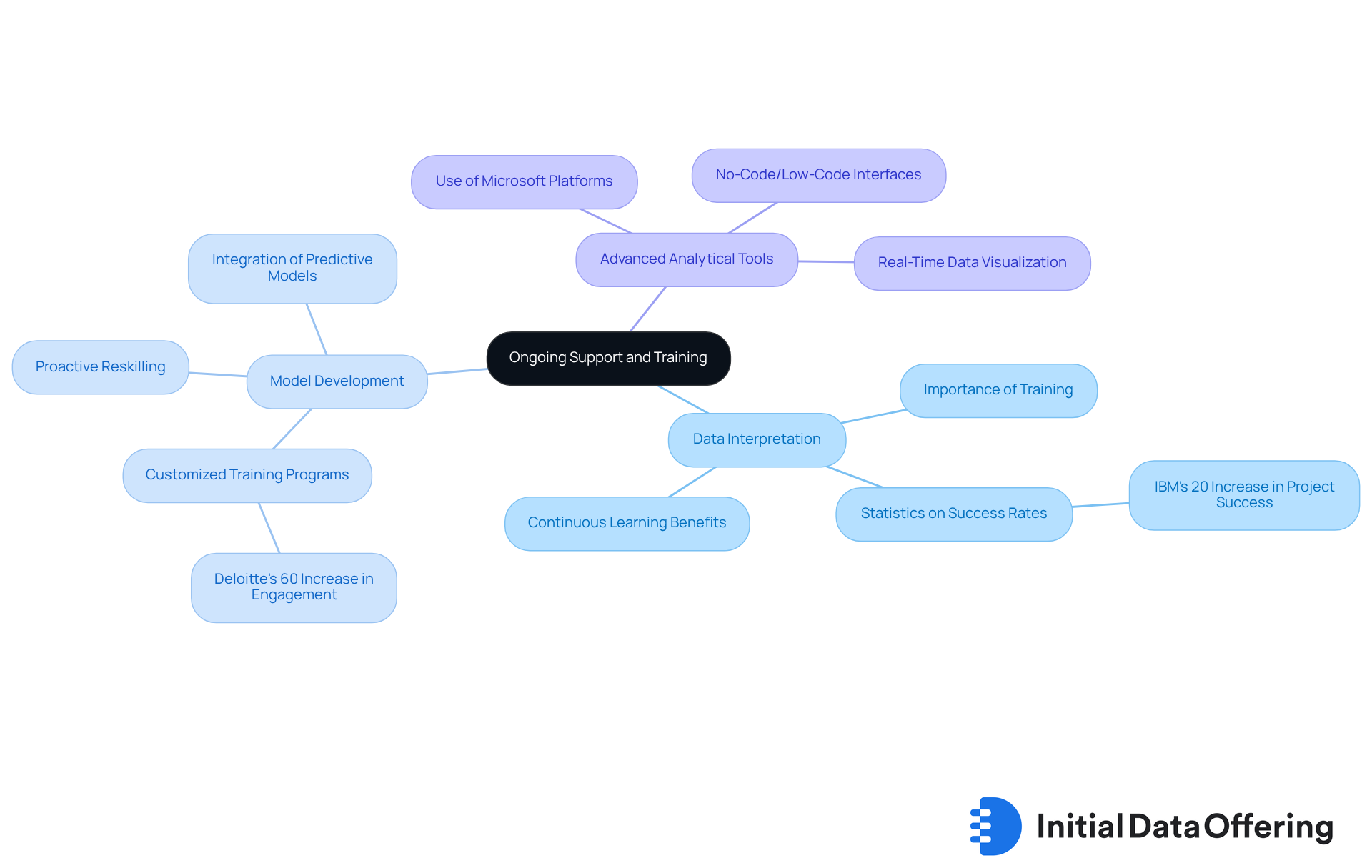
Conclusion
The transformative power of predictive analytics consulting is evident across various sectors, enabling organizations to harness data-driven insights for strategic growth and enhanced decision-making. By integrating advanced technologies and tailored solutions, businesses can effectively navigate market complexities and anticipate consumer needs. This ultimately leads to improved operational efficiency and a competitive advantage.
Key insights from the discussion highlight:
- The importance of quality datasets
- The role of predictive analytics in cost savings
- The necessity of ongoing support and training for teams
Organizations that embrace these principles are better positioned to mitigate risks, optimize resources, and enhance customer satisfaction. This proactive approach drives long-term success.
As the landscape of predictive analytics continues to evolve, it is imperative for businesses to invest in scalable solutions and advanced technologies like AI and machine learning. By doing so, they not only future-proof their operations but also empower their teams to leverage data insights effectively. The call to action for organizations is clear: prioritize predictive analytics consulting as a cornerstone of strategic planning to unlock unparalleled growth and innovation in an increasingly data-driven world.
Frequently Asked Questions
What is the Initial Data Offering (IDO)?
The Initial Data Offering (IDO) is a platform that simplifies the introduction and exploration of new datasets, providing market analysts with access to high-quality information essential for predictive analytics consulting.
Why is high-quality data important for companies?
High-quality data is critical for informed decision-making in market research, with 71% of companies acknowledging its importance.
How does IDO enhance dataset visibility?
IDO curates datasets across various domains, including finance, social media, and environmental studies, significantly enhancing the visibility of valuable resources for market analysts.
What role does predictive analytics consulting play in data-driven strategies?
Predictive analytics consulting utilizes the integrity of datasets to improve the accuracy of predictive models, helping organizations mitigate risks and support strategic initiatives.
How does IDO keep users informed about trends?
IDO adds new datasets daily, ensuring users are updated on the latest trends and insights necessary for effective forecasting.
What benefits do companies gain from predictive analytics consulting?
Companies can make informed decisions by analyzing historical data and identifying trends that forecast future outcomes, enhancing strategic planning and responsiveness to market shifts.
Can you provide examples of companies using predictive analytics?
Retailers like Walmart use forecasting to manage inventory efficiently, while UPS analyzes data to refine delivery routes, reducing costs and improving customer satisfaction.
What impact does forecasting data have on decision-making?
56% of companies report that forecasting data leads to quicker and more efficient decision-making, reinforcing its importance in a fast-paced market environment.
How can predictive analytics improve operational efficiency?
Predictive analytics can reduce operational expenses by enhancing resource distribution, minimizing waste, and identifying potential equipment failures to prevent costly downtime.
What are the financial benefits of implementing predictive analytics?
Organizations can achieve significant cost reductions, with anticipatory maintenance lowering maintenance costs by up to 40% and improving equipment reliability by 30-50%, leading to better ROI ratios.